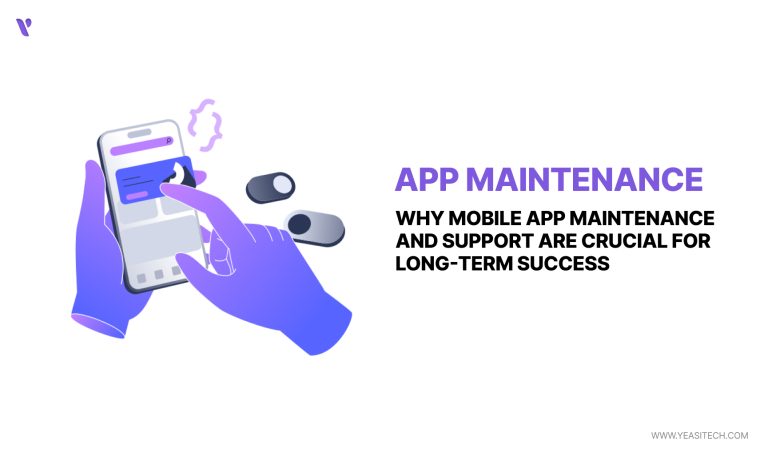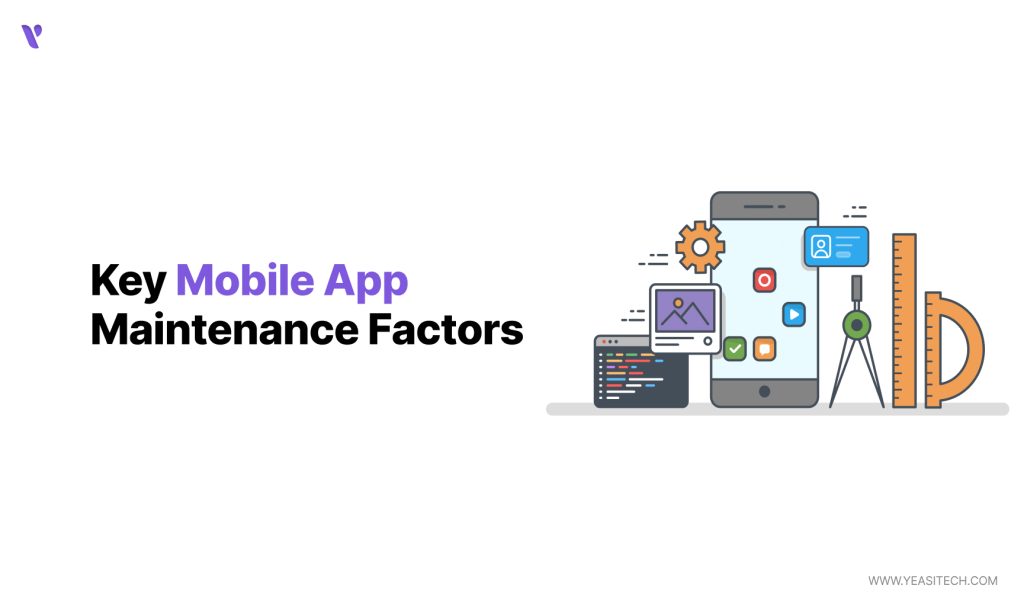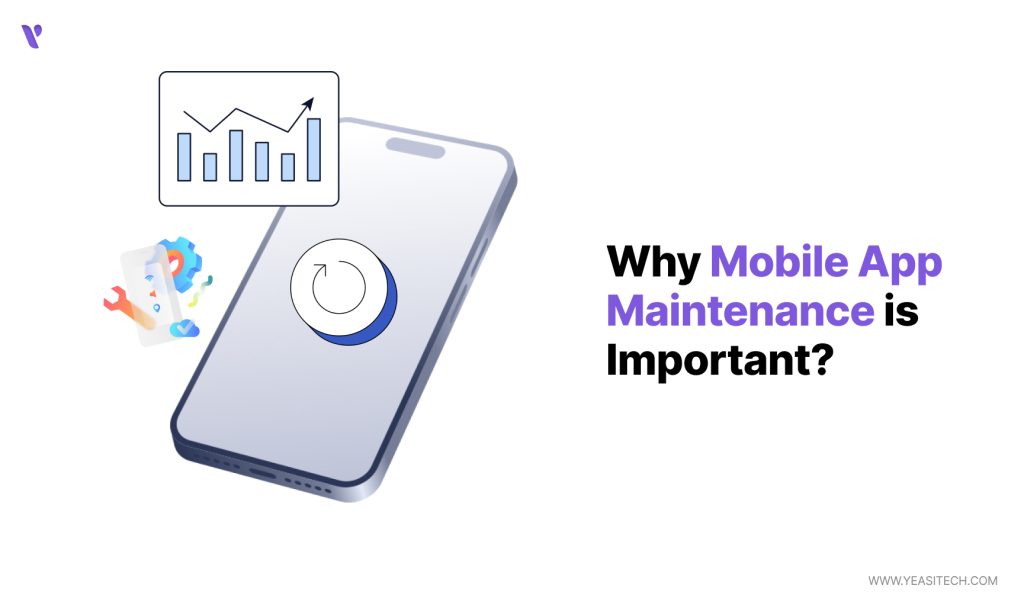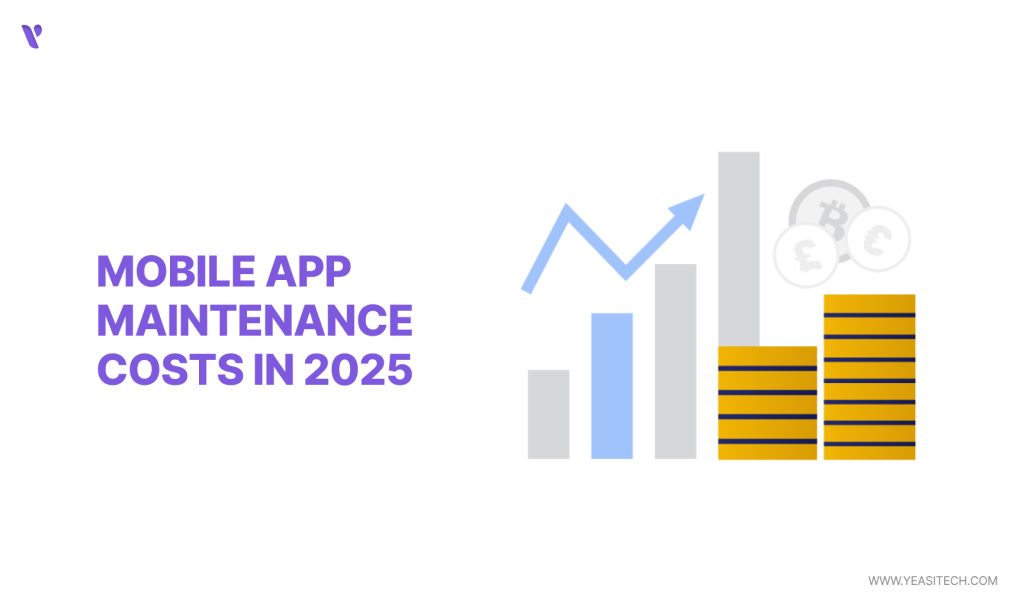Why Mobile App Maintenance Matters in 2025

To reach your goals, you need to check, improve, and update the mobile app often after it is launched. Constant and routine mobile app maintenance and support is significantly less expensive than letting problems grow into later, more complicated issues.
This blog post will explain the important parts of taking care of a mobile app and why they are important for your app’s growth and success over time.
If you own or create a mobile app, you want it to work well all the time. This is important whether you want to make money, get more users, or build trust with your audience.
To keep your app running smoothly and meeting users’ needs, you need to update it regularly and take care of any issues. This helps your app stay useful and competitive in the fast-changing digital world..

Let’s look into the important factors of mobile app maintenance and why it is necessary for long-term success:
With tech giants like Apple and Google rolling out major updates annually, your app must stay compatible. For example, iOS 17 introduced new features like improved widgets and Focus Modes, requiring apps to adapt for optimal performance.
More than 60% of apps require modifications to be compatible after three months of a significant update to mobile operating systems like iOS and Android, which often receive updates, according to Statista.
Even if your mobile app has been thoroughly tested before launch, users may still experience errors or difficulties. Mobile app maintenance improves the user experience by promptly resolving these issues.
Example: In 2020, users of WhatsApp on Android smartphones complained about the app stopping while transmitting media files. After receiving multiple complaints, the company found the issue and promptly released a bug-fix update, improving the app’s stability and guaranteeing that users could continue sending messages without any disruptions.
Pro Tip: Use error tracking tools like Sentry or BugSnag for real-time bug detection.
Cybersecurity risks are constantly changing. Frequent maintenance of mobile apps lowers the danger of vulnerabilities and hackers. Without updates, apps that were safe at launch might become vulnerable. Making cybersecurity a top priority helps users trust you by protecting their data.
The 2024 Verizon data breach investigations report shows a 25% rise in attacks directed at mobile apps. Patches must be applied frequently to protect user data.
Regular mobile app maintenance ensures a smooth user experience, preventing performance issues like slow load times or crashes. As user numbers and data increase, apps can become sluggish, leading to frustration, negative reviews, and potential abandonment. Regularly monitoring performance and making improvements enhances the overall user experience.
A 2023 Clevertap survey found that 62% of users will remove an app after a negative experience.
Mobile app maintenance ensures your app runs smoothly, while support focuses on helping users and improving the app’s design. It involves answering questions, fixing problems, and offering assistance to users.
Example: Uber handles thousands of daily customer service requests, from fare disputes to app navigation issues, ensuring timely resolutions. Regular app updates enhance support tools and response times, boosting user satisfaction.
To keep your mobile app competitive, it’s important to add new features or update existing ones to match user expectations. Regular app maintenance allows your developer to make these updates efficiently, ensuring your app stays fresh and engaging, and encouraging users to keep coming back.
Your app maintenance provider will keep vigilant tabs on and update critical APIs (application programming interfaces) for third-party services, such as payment gateways, social network connections, and cloud storage, to keep your mobile app operating properly.
Let’s read the best practices for mobile app maintenance in detail:
“Great things in business are never done by one person. They’re done by a team of people.” -Steve Jobs
If you want a professional app maintenance team that can help you throughout, contact us!

Let’s discuss the importance of mobile app maintenance one by one:
If your mobile app frequently crashes, has problems, or performs poorly, users are more likely to uninstall it. An effective mobile app maintenance strategy helps ensure that the app functions properly and keeps users satisfied and loyal over time. Positive ratings, in-app purchases, and referrals to the app are all more likely to come from happy users.
Your app must always function at its peak if your revenue targets rely on in-app sales, advertisements, or subscriptions. Issues like bugs or outages might reduce conversions and income. Experts in mobile app maintenance make sure your app is always functioning properly, lowering risks, keeping you ahead of the competition, and improving revenue.
You should regularly maintain and monitor your mobile app to address security flaws, reduce the risk of cyberattacks, and increase user confidence. You must conduct regular security tests and assessments to preserve client and company data, which is crucial for maintaining a good reputation and financial health.
Slow mobile apps can frustrate users and hurt their experience. Regular maintenance helps reduce downtime, ensuring your app runs smoothly. This keeps your app ready for business, satisfies users, and protects your reputation and reliability.
Regular mobile app maintenance helps you identify and fix issues early, saving you money on expensive repairs later. Skipping updates or bug fixes now can result in more complicated and costly problems in the future.
Working with a mobile app maintenance provider keeps you prepared for changes in user needs. Whether it’s new technologies, design trends, or shifting user preferences, having a maintenance partner helps you adapt quickly and stay relevant in the long run.
Users are likely to leave negative reviews if your mobile app performs poorly, lowering its visibility and ranking in app store searches. By maintaining your app regularly, you can help improve its performance, resulting in more positive reviews and a higher ranking in app store listings.
Maintaining a mobile app is not a one-size-fits-all task. It involves various categories:
Let’s look into some real-life inspiring stories and learn from them:
Challenge:
WhatsApp, the most popular messaging application around the world, had trouble expanding its server capacity and implementing features like payment integrations and disappearing messages.
Maintenance Approach:
Users trust the app due to its regular upgrades, feature improvements, and safety enhancements, such as end-to-end encryption.
Impact: With over 2.5 billion active users (Statista, 2024), WhatsApp’s focus on maintenance has sustained its global dominance.
Challenge:
Starbucks’ mobile app initially faced usability issues with slow payment processing and occasional crashes.
Maintenance Approach:
Through regular performance updates and user feedback integration, Starbucks optimized its payment gateway and added features like app-exclusive promotions and order customization.
Impact:
The fact that orders placed through mobile apps will account for 25% of Starbucks’ sales in 2024 highlights how app maintenance may directly contribute to corporate expansion.
Challenge:
Amazon, one of the largest e-commerce platforms globally, faced app performance issues related to inventory tracking, loading speed, and product search accuracy. With a vast number of products and frequent sales events, these issues became a significant concern.
Maintenance Approach:
Amazon’s app maintenance focuses heavily on performance optimization, especially during high-traffic periods like Prime Day or Black Friday. Regular updates ensure product recommendations are personalized, search results are relevant, and cart transactions are seamless. They also optimize the app’s ability to handle millions of transactions per minute during peak periods, preventing app downtime.
Impact:
Amazon supports over 300 million active users globally with continuous updates and optimizations, with its mobile app driving over 70% of e-commerce sales. Ongoing maintenance ensures quick recovery from technical issues, increasing customer retention and revenue growth.
Let’s look into the trend of mobile app maintenance that can be a game changer in 2025:
Let’s go over the challenges in mobile app maintenance and how we can overcome them:
Regular updates require resources.
Solution:
Use agile development practices to prioritize tasks efficiently and leverage cloud-based services to reduce infrastructure costs.
Maintaining compatibility across multiple OS versions is challenging.
Solution:
Testing platforms like BrowserStack are used to ensure seamless performance across devices.
Balancing user demands with business priorities can be tricky.
Solution:
Technologies like UserVoice can be used to classify input into insights that can be used.

The cost of maintaining a mobile app varies depending on its complexity:
Even while these expenses might seem expensive, they are greatly outweighed by the return on investment in terms of income, brand reputation, and user retention.
Please get in touch with our team if you would like a fair idea about the cost estimate. Our team will assess your needs as a business and as a product before presenting an elaborate cost estimate.
In 2025, mobile app maintenance will be mandatory. It’s an essential tactic for maintaining long-term success, retaining consumers, and being competitive. Businesses can fully utilize their apps by investing in frequent upgrades, improving performance, and maintaining strong security.
If you’re ready to elevate your mobile app’s performance and ensure its long-term success, visit YeasiTech for professional app maintenance services tailored to your needs.
Make your app future-ready—because your users deserve the best!
Mobile app maintenance keeps your app functional, secure, and compatible with new operating systems. Regular updates improve user experience, fix bugs, boost performance, and prevent security risks. Without it, businesses may lose users and revenue.
Mobile apps should be updated every 2-3 months to ensure compatibility with the latest OS versions, fix bugs, and introduce new features. Regular updates help keep users engaged and improve retention rates.
Regular updates, bug repairs, speed optimization, security patches, and feature enhancements are all part of app maintenance services, which make sure an app functions properly and is compatible with the newest hardware and operating systems.
App maintenance costs depend on complexity, platform, update frequency, and support needs. It typically costs 15–25% of the development cost per year, with major changes costing thousands and minor updates a few hundred dollars.
Maintaining an app is a continuous process. While large updates or feature additions can take weeks or even months, depending on their complexity, minor updates and bug fixes might just take a few hours to a few days.
Mobile app maintenance ensures that an app remains functional, secure, and efficient over time. It includes fixing bugs, updating software for new OS versions, optimizing performance, and adding new features based on user feedback.
Regularly updating an app keeps it safe, prevents crashes, makes users happy, and ensures it works with new technology. Ignoring updates can cause security risks, slow performance, and loss of users.
YeasiTech is a trusted IT service partner with 8+ years of experience, empowering 250+ businesses with scalable web, mobile and AI solutions.
Explore related topics to broaden your understanding and gain actionable insights that can transform your strategies.